Abstract
Background
Thousands of healthcare mobile applications (apps) are available, and physicians are increasingly recognizing that mobile technology can improve their workflow and allow them to practice medicine in a better and/or more efficient manner.
Methods
This article highlights apps compatible with the iPhone and iPad and their utility to the busy orthopedic surgeon.
Results
Currently available apps address every aspect of healthcare: patient management, reference, education, and research.
Conclusion
Key aspects of helpful apps include low cost (preferably free), a user-friendly interface, and simplicity.
Keywords: Cellular phone, computers–handheld, information science, mobile applications
INTRODUCTION
The paradigm for accessing clinical information has changed dramatically with the availability of smartphones and other devices with their accompanying applications or apps. Physicians are using mobile apps to access patient information in ever-increasing numbers. The Manhattan Research study released in May 2011 estimated that 75% of US physicians own some form of Apple mobile device such as an iPhone, iPad, or iPod.1 The study also identified the iPhone as the top smartphone choice for physicians in general and estimated that more than 30% of physicians use an iPad. This number was predicted to double by 2012. Usage figures continue to grow yearly as newer and more advanced technology is introduced.
More than 10,000 healthcare apps are available for iOS, the operating system that powers Apple handheld devices. A common perception in the past was that healthcare information technology management lagged behind the technology curve; however, the healthcare industry is now on the cutting edge of using mobile devices for data management. Apps are available for all aspects of medicine, including patient management, reference, education, and research. Many physicians recognize that mobile technology can improve their workflow and can help them practice medicine in a better and/or more efficient manner.2 Many surgeons feel the iPad helps them interact with their patients more effectively by removing the tether to a wired workstation.
In the past few years, interest in iPad utilization in graduate medical education has increased.3 iPad utilization has become an everyday part of many orthopedic residency programs in the country. In hospitals that have transitioned to electronic medical records (EMRs), residents can quickly check laboratory results, notes, and x-rays on their iPads. In addition, mobile devices can help ensure continuity of care. Resident work-hour restrictions can have an impact on continuity of care and the potential for medical errors. At our institution, a major focus has been the transition of care between residents. Distribution of iPads to all residents at our facility and the implementation of a procedure for checkout progress notes have significantly helped residents on call and on night float rotations. These checkout notes are easily viewed on the iPad and allow quick access to potential on-call issues.
HEALTHCARE APPS FOR THE iOS OPERATING SYSTEM
The following sections highlight apps compatible with the iPhone and iPad and their utility to the busy orthopedic surgeon. This discussion is not comprehensive but instead presents apps that were available in fall 2014 and that we and our colleagues have found useful.
Remote Desktop Clients
The remote desktop protocol (RDP) app allows users to run a mirror of their desktop computer or a workstation computer on their mobile device (Table 1). Limited screen space can be a problem when trying to view images that are easily viewable on a 17-inch computer monitor, so a complementary strategy is to run native apps on the device. These apps are specific programs that allow viewing of picture archiving and communication system (PACS) images, medical records, outcome scoring, and CPT (Current Procedural Terminology) and ICD-9 (International Classification of Diseases, version 9) coding.4 Because native apps are designed for a specific device, they are readable, responsive, and user friendly.
Table 1.
Remote Desktop Protocol Applications
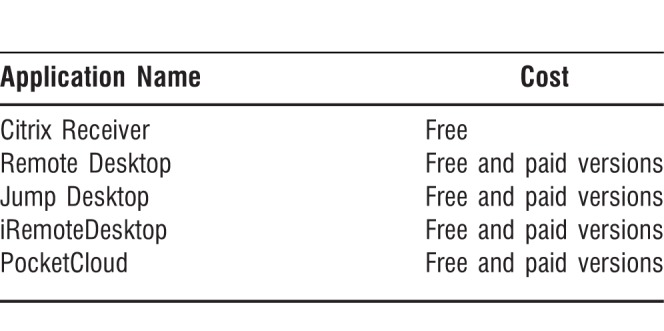
One of the disadvantages of an RDP is the need for a network connection such as wi-fi that may affect responsiveness. A combination of both strategies appears to be the most effective way to efficiently analyze and gather information. Running an RDP that reproduces the usual workstation screen supplemented with device-specific apps will accelerate clinic interactions.
Electronic Medical Records
Most orthopedic practices have invested in a form of EMR since the paradigm shift from paper charts. The easiest implementation for EMR viewing on an iPhone or iPad is through RDP apps. The disadvantage is that navigating the menus and submenus of the EMR on an iPhone or iPad can be difficult. As an alternative, most EMR systems have associated EMR apps that are user friendly and useful for quick data lookup such as laboratory results or notes from other providers.
Image Viewing
Because most healthcare facilities have invested in PACS software, the easiest way to view x-rays is via an RDP. Based on our experience, the iPad is superior to the iPhone or iPod Touch for viewing RDP images because of resolution restrictions. Because personal digital assistant (PDA) devices and mobile phones are available throughout the world, radiologic software for PDAs and mobile phones has been developed.5 One study evaluated the accuracy of appendicular trauma x-ray interpretation on smartphones compared with PACS workstations. The results showed that the accuracy of interpretation of appendicular trauma radiographs on the Apple iPhone was high, ranging from 93%-98%. The researchers concluded that smartphones have a future role in providing second opinions for appendicular trauma.6
Apps designed for viewing images, such as Mobile MIM, provide quality images even on small screens such as an iPhone or iPod Touch (Table 2). As more x-ray apps become available and their quality improves, orthopedic surgeons will find utility in easy access to diagnostic imaging.
Table 2.
Image Viewing Applications
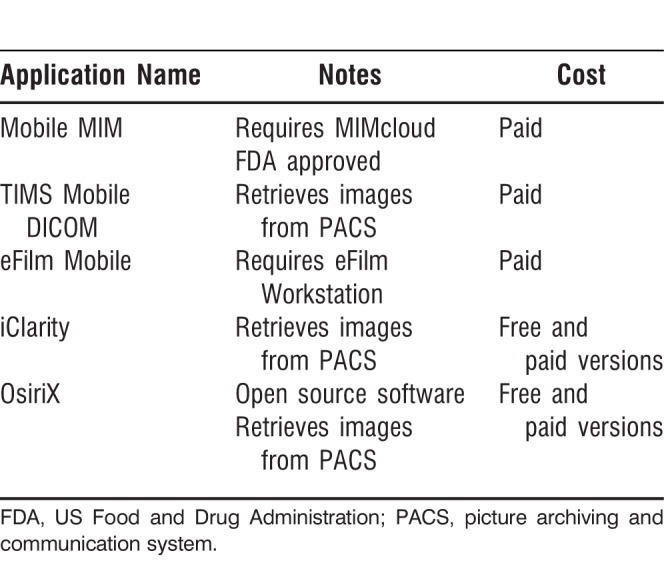
Dictation and Transcription
Apple devices can be used as digital recorders, and many dictation programs exist. Dictate + Connect, Dragon Dictation, and iTalk Recorder are the recording apps our colleagues found to be the most helpful. Dictate + Connect is a paid app. Dragon Dictation and iTalk Recorder are free. For all these apps, the voice files must be emailed to a transcriptionist. The Dragon Dictation app can transcribe relatively simple messages, but the amount of text is limited, and a connection to the internet is required. This app is useful for dictating quick emails addressing simple requests.
More sophisticated dictation systems require a subscription to a transcription service. The dictated audio file is sent to a transcription service, and a transcribed version is returned. Such services can be expensive, and determining whether the service is worth the expense is a decision for each individual practice. Services include iTranscribe, Entrada, d2u Transcriber, Voxie for Medical, and Dragon Medical Mobile Recorder.
Medical Photography
Photography is the easiest way to document the initial severity of an injury in a trauma scenario. Using smartphones for teleconsultation has been proven to be an effective way to remotely manage orthopedic trauma patients.7 Small centers can consult orthopedic specialists through multimedia messaging to decide whether a transfer to a higher level center is appropriate. In addition to the built-in camera app on the iPhone and the iPad, other apps for taking digital pictures are available, such as the free Camera Zoom and Camera Flash and the paid Camera Genius. Video can be used to record deficits or disease states that require active movement.
Photo-Sort is a paid app that helps create order by indexing a photo collection. If you need to store clinical patient images on a personal device, the free Photo Safe Pro app provides a way to hide and secure the photos.
Because of potential Health Insurance Portability and Accountability Act (HIPAA) violations, clinicians must know their institution's policy on medical photography. Some institutions allow pictures to be taken in the operating room or clinic if the photos are immediately downloaded to the institution's imaging archiving systems. Some EMR apps such as Epic's Haiku/Canto upload photos taken with a device's built-in camera to a patient's medical record without saving a copy on the physician's device. Photos can be especially helpful when other services such as plastic surgery or wound care can view a photo of the wound on the orthopedic surgeon's daily progress note instead of having to remove the patient's bandages.
Outcome Scores
Several apps help measure outcomes by utilizing standardized orthopedic scoring system outcome assessments for the hip, knee, shoulder, elbow, wrist, foot, ankle, and spine (Table 3). Most of these apps allow the information to be summarized so it can be dictated, cut and pasted, or emailed to a patient's medical record.
Table 3.
Orthopedics Outcome Measures Applications
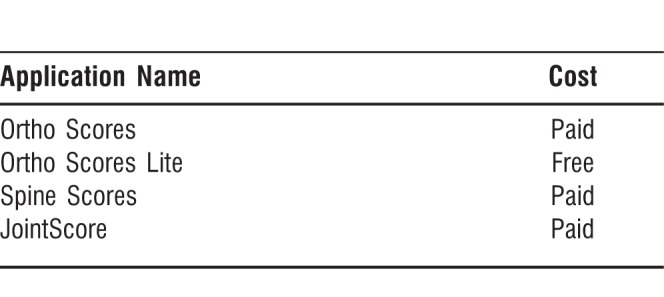
Clinical Evaluation
Our colleagues have not found apps with goniometers and x-ray angle measuring capabilities particularly useful because they are not accurate enough to use in routine clinical settings. The one clinical evaluation app that deserves mentioning is FRAX, a low-cost fracture risk assessment tool that uses World Health Organization standards. For orthopedic surgeons engaged in fracture care, FRAX could be useful because it may provide one of the metrics for pay-for-performance or quality-of-care assessments.
Coding
Our preferred apps for diagnosis and procedural coding are listed in Table 4. With the release of ICD-10, the ICD-9 apps will be updated. Diagnosis and procedural coding apps tend to be more expensive than other types of healthcare apps, but the American Academy of Orthopaedic Surgeons (AAOS) offers AAOS Orthopaedic Code-X Lite 2014, a free and helpful coding app.
Table 4.
Coding Applications
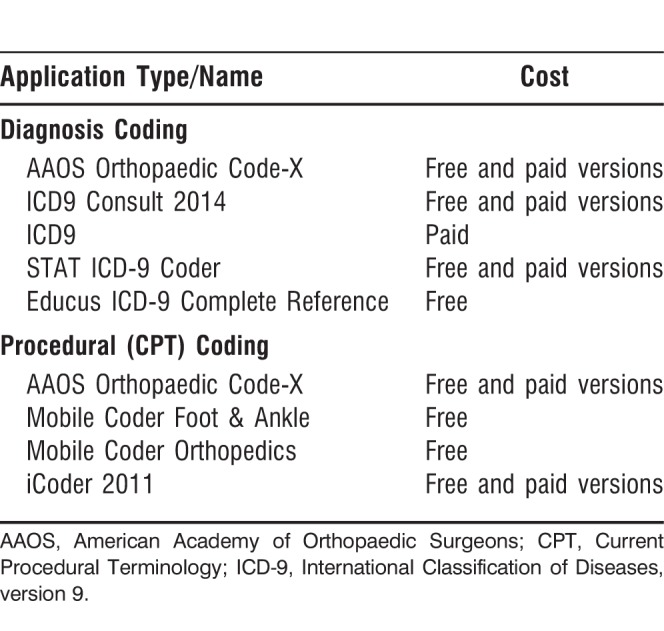
Communication
Despite the rapid evolution of handheld technology, communication among surgeons has changed little in 25 years. The introduction of the pager was the last major change in physician communication. Pager technology is outdated because of the limited amount of information that can be transferred in an encounter and the significant amount of time wasted waiting for return calls. Based on a qualitative study of communication challenges in 7 hospitals conducted by the Center for Health Information and Decision Systems (CHIDS), researchers estimated that US hospitals waste $12 billion annually because of poor communication. For a typical 500-bed acute-care hospital, communication problems between physicians and nurses create an annual $4 million economic burden, including increases in the length of hospital stays.8 Because of this outdated communication system, many physicians have resorted to communicating through other means, including secured email systems and unsecured systems such as text messaging. The Joint Commission has effectively banned physicians from sending traditional text messages that contain patient information. Violations of HIPAA can lead to fines of $50,000-$1.5 million in a single year.9
The ease and familiarity of text messaging systems have led to well-designed programs such as TigerText, a secure mobile messaging platform through which hospital staff can text, comment, ask questions, and send pictures to each other in a secure, protected network. The app also permits group texts between care teams. For example, this app would allow quick communication between the emergency department, orthopedics, and general surgery for the development of a surgical plan and the disposition of a trauma patient who presented to the emergency department with femur fracture and liver laceration.
The FaceTime app can be used for telemedicine. FaceTime is not secure, so clinicians must obtain patient permission and carefully observe all HIPAA regulations. However, FaceTime has the potential to save a patient or a surgeon a trip to the emergency room by enabling evaluation of a patient concern. The built-in camera can be used to document the severity of an injury, as well as recovery in the clinic, operating room, or emergency room. However, we recommend knowing an institution's policies about such use and fully complying with the policies.
For communication that does not have to be secure, Skype, fring, and Google Voice work well on iOS devices and are free. Google Voice is an option for consolidating home, work, and cell phone numbers into one number.
Reference
Reference apps are available for laboratory results, medical calculations, anatomy, and drugs (Table 5).
Table 5.
Reference Applications
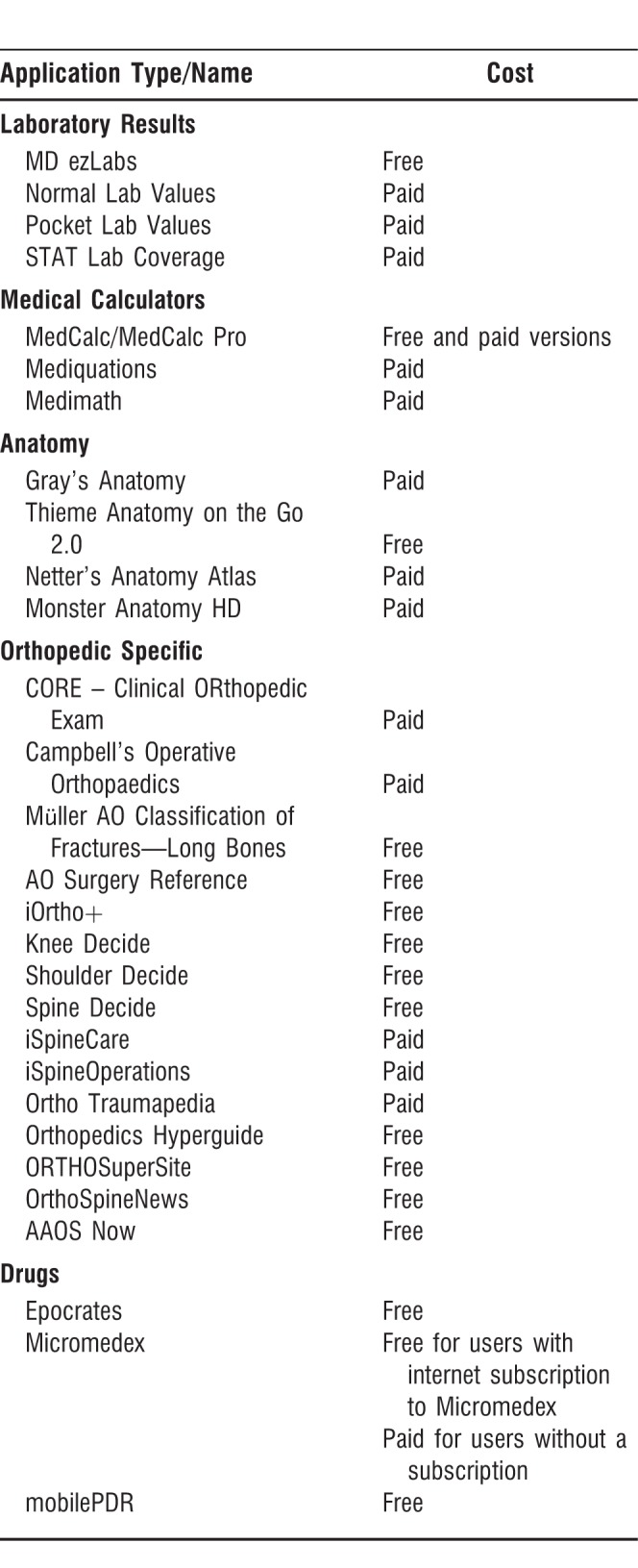
The apps available for evaluating laboratory values offer quick look-up capabilities, so personal preference of the app interface will be the deciding factor in choosing which to use.
Medical calculator apps provide access to complicated medical formulas, scores, scales, and classifications.
Many apps can be used to teach medical students the musculoskeletal anatomy and to review disease pathology with patients. One of the most helpful apps for teaching patients about anatomy and surgery is Monster Anatomy HD. On an iPad, high-quality pictures supplement the discussion so patients can see what the clinician is describing. CORE (Clinical ORthopedic Exam) is a reference tool for diagnosing musculoskeletal and orthopedic disorders.
Free and paid versions of medication apps are available. Although the paid apps are more thorough and provide more information, the free versions are sufficient for the daily practice of an orthopedic surgeon.
Research
Several free PubMed apps are available for performing literature searches on mobile devices. Papers and PubMed Library are helpful paid apps, especially for orthopedic surgeons involved in academic endeavors. The free iBooks app can be used to view books in PDF or EPUB format. However, more sophisticated paid programs such as GoodReader, iAnnotate PDF, and SoundNote allow annotating and highlighting. Free and paid versions of the Documents To Go app allow the viewing of Microsoft Office Suite files. Apple also offers Pages, Numbers, and Keynote, paid apps that offer functions similar to Word, Excel, and PowerPoint. Although these apps are useful, they do not offer the same range and complexity of the programs in the Microsoft Office Suite.
A helpful free handwriting app for the iPad called Penultimate allows the user to write notes as if writing in a notebook. The files are stored like notebook pages.
Built-In Apps
The iOS operating system has useful built-in apps. The Calendar app can sync with Microsoft Exchange Server or with Apple's iCloud service and provides a convenient way to keep track of meetings, surgeries, and other events. The iCloud service allows users to store data such as music and iOS applications on remote computer servers for download to multiple devices such as iOS-based devices running iOS 5 or later.
Miscellaneous
Dropbox and SugarSync provide virtual drives in the cloud that allow free data storage and easy access across many devices and platforms. Apple's iCloud service and the Air Sharing HD app are also useful syncing apps.
Medical translation can be challenging in the clinical setting, and Google Translate is an easy-to-use free solution. The app requires an internet connection but is helpful when traditional translators are not available. However, having an authorized translator physically present when patients are signing important documents, such as surgical consent forms, is recommended.
The free maxRVU app helps the clinician capture all relative value unit billing data.
The free Apello patient tracker app can be used to manage a large inpatient census.
Adobe Ideas is a free app that allows the creation of digital forms. The user can circle yes/no, mark checkboxes, and enter text. The information from the forms can be populated into databases, providing the advantage of digital data collection for patient intake or clinical research.
OrthoEvent can be used to search for orthopedic conferences in locations around the world.
CONCLUSION
Key aspects of helpful apps include low cost (preferably free), a user-friendly interface, and simplicity. Mobile devices and apps will play an increasingly integral role in the provision of excellent orthopedic surgery patient care.
Footnotes
The authors have no financial or proprietary interest in the subject matter of this article.
This article meets the Accreditation Council for Graduate Medical Education and the American Board of Medical Specialties Maintenance of Certification competencies for Patient Care and Medical Knowledge.
REFERENCES
- 1.New York, NY: Manhattan Research, Decision Resources Group; 2011. 75 percent of U.S. physicians own some form of Apple device according to new Manhattan Research study [press release] May 4, http://manhattanresearch.com/News-and-Events/Press-Releases/physician-iphone-ipad-adoption. Accessed August 13, 2014. [Google Scholar]
- 2.Burdette SD, Herchline TE, Oehler R. Surfing the web: practicing medicine in a technological age: using smartphones in clinical practice. Clin Infect Dis. 2008 Jul 1;47(1):117–122. doi: 10.1086/588788. [DOI] [PubMed] [Google Scholar]
- 3.Lobo MJ, Crandley EF, Rumph JS, et al. Pilot study of iPad incorporation into graduate medical education. J Grad Med Educ. 2013 Mar;5(1):142–144. doi: 10.4300/JGME-D-12-00007.1. [DOI] [PMC free article] [PubMed] [Google Scholar]
- 4.Dala-Ali BM, Lloyd MA, Al-Abed Y. The uses of the iPhone for surgeons. Surgeon. 2011 Feb;9(1):44–48. doi: 10.1016/j.surge.2010.07.014. [DOI] [PubMed] [Google Scholar]
- 5.Drnasin I, Grgic M. 52nd International Symposium ELMAR 2010. Zadar, Croatia: Croatian Society Electronics in Marine, 2010; The use of mobile phones in radiology. http://www.vcl.fer.hr/papers_pdf/The%20Use%20of%20Mobile%20Phones%20in%20Radiology.pdf. Accessed October 6, 2014. [Google Scholar]
- 6.Chew NS, Tsukagoshi DR, Roberton BJ, Healy JC, Lee JC. Radiological Society of North America 2008 Scientific Assembly and Annual Meeting. Chicago, IL: Are second opinions on appendicular skeletal trauma accurate on smartphones? Accuracy and interobserver variability compared to diagnostic picture archiving and communications systems (PACS) workstations. February 18-20, 2008. http://archive.rsna.org/2008/6018159.html. Accessed October 6, 2014. [Google Scholar]
- 7.Elkaim M, Rogier A, Langlois J, Thevenin-Lemoine C, Abelin-Genevois K, Vialle R. Teleconsultation using multimedia messaging service for management plan in pediatric orthopaedics: a pilot study. J Pediatr Orthop. 2010 Apr-May;30(3):296–300. doi: 10.1097/BPO.0b013e3181d35b10. [DOI] [PubMed] [Google Scholar]
- 8.Agarwal R, Sands DZ, Diaz-Schneider J. Center for Health Information and Decision Systems Research Briefing (3:1B) College Park, MD: Robert H. Smith School of Business, University of Maryland; 2008. Quantifying the Economic Impact of Communication Inefficiencies in US Hospitals. [Google Scholar]
- 9.Brooks AA. Healthcare texting in a HIPAA-compliant environment. AAOS Now. August 2012. http://www.aaos.org/news/aaosnow/aug12/managing5.asp. Accessed August 13, 2014. [Google Scholar]


